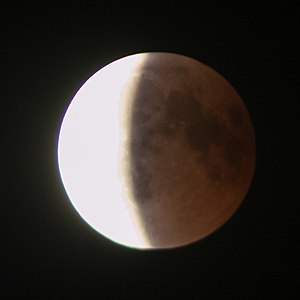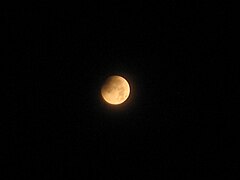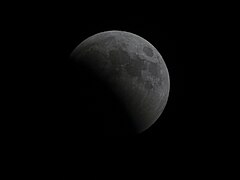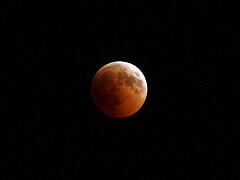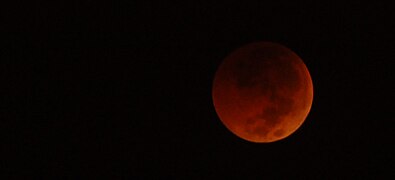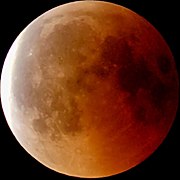Lunar eclipse of July 27, 2018
| Total lunar eclipse on July 27, 2018 |
|
|---|---|
 View of the blood moon in Italy during totality |
|
Ecliptic North Up The moon moves through the umbra of the earth.
 |
|
| Saros cycle | 129 (38 of 71) |
| gamma | +0.1168 |
| Duration (hours: minutes: seconds) | |
| totality | 1:42:57 |
| Partiality | 3:54:32 |
| Penumbrality | 6:13:48 |
| Contacts ( UTC ) | |
| P1 (start of penumbrality) | 17:14:49 |
| U1 (start of partiality) | 18:24:27 |
| U2 (start of totality) | 19:30:15 |
| Maximum eclipse | 20:21:44 |
| U3 (end of totality) | 21:13:12 |
| U4 (end of partiality) | 22:19:00 |
| P4 (end of penumbrality) | 23:28:39 |
The lunar eclipse of July 27, 2018 was the second and last lunar eclipse of 2018 , after the lunar eclipse of January 31, 2018, and the longest lunar eclipse of the 21st century.
During the six-hour passage through the Earth's shadow, the moon moved almost centrally through the Earth's umbra, and the blood moon therefore became particularly dark. The total lasted just under an hour and 43 minutes.
This lunar eclipse is the 38th lunar eclipse of the 129th Saros cycle .
visibility
The entire course of the total lunar eclipse could be observed in East Africa , in South and Central Asia as well as in the Indian Ocean and Antarctica . It was observed in South America , West Africa and Europe during the rising of the moon and in East Asia and Australia during the moonset .
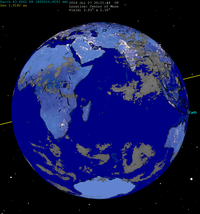 View of the earth from the closest point of the moon during maximum eclipse |
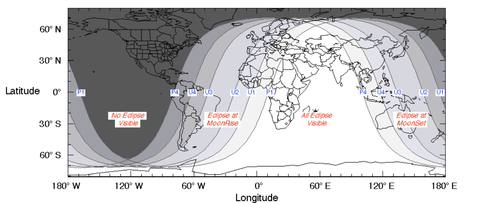 World map with the limits of visibility |
Europe
In Europe, the penetration was in the penumbra not observed (time P1 = start Penumbralität) because the moon only after the penetration into the umbra opened (time = U1 beginning of partiality) in the southeast. At most European observation sites, it was only visible during totality (after time U2) because only then was it sufficiently high above the horizon. The maximum of the eclipse took place at 10:22 p.m. ( CEST = UTC + 2 hours). The entire process of leaving the Earth's shadow could be observed from 11:13 p.m. (CEST). At the moonset the moon was already visible again as a full moon .
Observations from different places
- Animations from the lunar eclipse of July 27, 2018
Video of the lunar eclipse of Yekaterinburg , Russia
- Lunar eclipse of July 27, 2018 in chronological order
Observed in Tashkent , Uzbekistan at 19:32 UTC
Observed in Davao City , Mindanao , Philippines at 19:52 UTC
Observed in Germany at 22:01 UTC
Simultaneous Mars opposition

At the same time as the lunar eclipse, when the moon is in opposition to the sun, Mars, six degrees below the moon, was in opposition to the sun. Thus it was in line with the earth-moon system and had a particularly small distance to the earth, as it will only appear again after about 20 years.
Mars therefore currently has a large apparent magnitude of almost -3 magnitudes. Although it did not appear as bright as the unshaded full moon before and after the eclipse, it was clearly brighter than the blood moon during totality. Even in binoculars or in the telephoto lens it was not only recognizable as a glowing red point, but also as a small disc. Its apparent diameter (about 24 arc seconds ) was about 70 times smaller than the moon (about 29.5 arc minutes ).
Such a constellation with simultaneous opposition to the moon and Mars only occurs every 25,000 years.
Web links
Individual evidence
- ↑ In 2018 the longest lunar eclipse will take place in 100 years ( en-US ) December 29, 2017.
- ↑ a b Mars / data July 27, 2018 , CalSky, accessed August 8, 2018
- ↑ Moon / Dates July 27, 2018 , CalSky, accessed August 8, 2018
- ↑ Два редких астрономических явления можно будет наблюдать 27 июля ( Russian ) TASS . July 26, 2018. Retrieved July 26, 2018.
